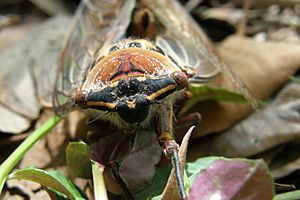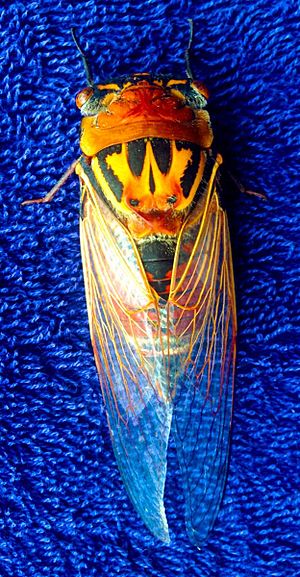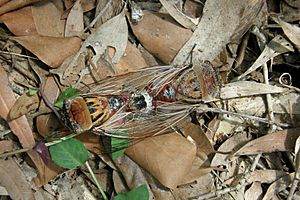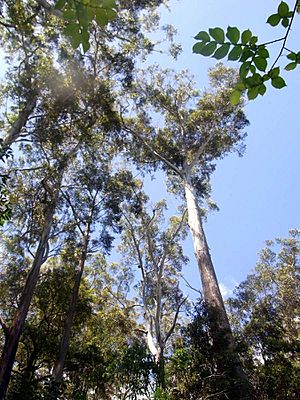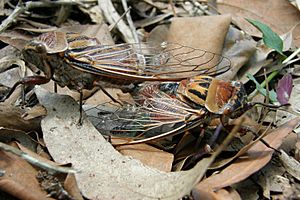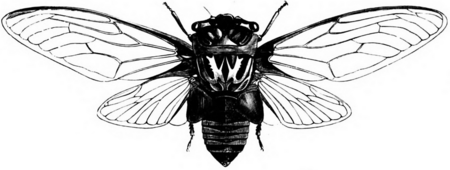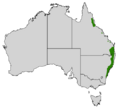Double drummer facts for kids
Quick facts for kids Double drummer |
|
|---|---|
 |
|
| T. saccata male specimen on display at the Australian Museum | |
| Scientific classification | |
| Genus: |
Thopha
|
| Species: |
saccata
|
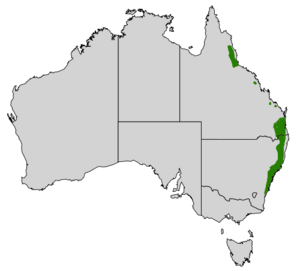 |
|
| Thopha saccata range | |
| Synonyms | |
|
|
The Thopha saccata, also known as the double drummer, is the biggest cicada in Australia. It is also thought to be the loudest insect in the world! A Danish scientist named Johan Christian Fabricius first described it in 1803. This made it the very first Australian cicada to be officially named.
Its common name, "double drummer," comes from the large, dark red-brown sac-like pockets on the male's sides. These "drums" help make its sound much louder. The double drummer cicada has a wide head compared to other cicadas. It is mostly brown with black patterns on its back. Its underside is red-brown and black. Males and females look similar, but only males have the special sound-making sacs.
You can find double drummers in sclerophyll forests in Queensland and New South Wales. Adult cicadas usually sit high up in large eucalypt trees. They emerge from the ground between November and March. Before this, they spend several years living underground as nymphs. Once they emerge, adult cicadas live for about four to five weeks. Some years, many double drummers appear, while in other years, there are very few.
Contents
Naming the Double Drummer
The Danish scientist Johan Christian Fabricius first described the double drummer in 1803. He named it Tettigonia saccata. This was the first time an Australian cicada was officially described. For some reason, he incorrectly thought it came from China.
Later, in 1843, French scientists placed it in a new genus called Thopha. The name Thopha comes from a Hebrew word meaning "drum." The second part of its name, saccata, comes from the Latin word for "sac" or "bag." This refers to the male cicada's special sac-like "drums."
In 1838, another scientist, Félix Édouard Guérin-Méneville, corrected that the double drummer is actually from Australia. The common name, "double drummer," also comes from the male cicada's two sac-like covers. These covers are on each side of its body and look like drums.
What Does It Look Like?
The adult double drummer is the largest cicada species in Australia. Males are about 4.75 cm (1.87 in) long, and females are about 5.12 cm (2.02 in) long. Its body is quite wide, especially its thorax, which is about 2 cm (0.79 in) across. The front wings can be 5 to 6.6 cm (2.0 to 2.6 in) long. The biggest one ever found had a wingspan of 15.1 cm (5.9 in).
Males have large, dark red-brown sacs on each side of their bodies. These sacs cover their tymbals. Tymbal are special parts that buckle to make the cicada's loud song. The cicada's head is very wide, wider than its neck area. Its head, antennae, and front face are black. It has small red ocelli, which are simple eyes.
The body is mostly brown, becoming lighter as the cicada gets older. Its back has clear black markings. The underside of the double drummer is red-brown and black. It is covered in fine, silvery hairs. Females have a very long egg-laying tube called an ovipositor, which is about 1.76 cm (0.69 in) long. The wings are clear and have light brown veins. Its legs are dark brown with grey hairs.
The double drummer looks similar across its range. However, some females can be darker overall. The double drummer is bigger and darker than its cousin, the northern double drummer.
The Loudest Insect Sound
Male cicadas sing to attract females. This sound is often called "the sound of summer." The double drummer's song is incredibly loud. It is said to be the loudest sound made by any insect! It can reach over 120 dB if many cicadas are singing close by. This is as loud as a rock concert!
The song sounds like a constant, buzzing drone, sometimes compared to high-pitched bagpipes. The sound is made when the tymbal plate buckles. This sound then echoes in a hollow space inside the cicada's body. It also resonates in the air-filled sacs on the outside, making the sound even louder.
The singing can stop and start suddenly. The song has two main parts. One part is a continuous call that can last for several minutes. The other part is a staccato sound, which means it has short, sharp breaks. These breaks can make it seem like the song stops, but it actually continues at a much lower volume.
Double drummers often gather in groups to sing. This makes their calls even louder. This loud group singing likely helps to scare away birds that might try to eat them. Male double drummers also make a sharp, broken noise if a predator grabs them. This is their distress call.
Life Cycle of the Double Drummer
Female double drummers lay their eggs in small cuts they make in tree branches or twigs. They usually choose eucalypt trees. On average, about twelve eggs are laid in each cut. A female can lay hundreds of eggs in total. These cuts can sometimes harm the bark of young trees.
The eggs usually hatch about 70 days later. They take longer to hatch if the weather is cold or dry. Once the tiny larvae hatch, they fall to the ground. Then, they burrow into the soil. We don't know exactly how long double drummer nymphs stay underground. However, cicada nymphs in general can live underground for four to six years.
Unlike most Australian cicadas, double drummers come out of the ground during the daytime. They often emerge in large groups. When they come out, they are covered in mud. They leave their old skin, called an exuvia, at the base of eucalypt trees. After leaving their old skin, the cicada's body and wings dry and harden.
Adult double drummers live for about four or five weeks. During this short time, they mate and lay eggs. They feed only on the sap from living trees, sucking it out with special mouthparts. Female cicadas die after they lay their eggs.
Where Do They Live?
The double drummer lives in different areas of Australia. You can find them in northern tropical Queensland, from Shiptons Flat south to Ingham. They are also found from Gympie in southeastern Queensland down to Moruya in southern New South Wales. In the northern parts of their range, they live in higher places. This is because the climate there is similar to southeastern Queensland.
Adult double drummers are present from November to early March. Some years, there are many of them, and other years, there are none. They live in dry sclerophyll forests. They prefer to sit and feed on large eucalypt trees. These trees usually have trunks wider than 20 cm (7.9 in). They also like trees with thin leaves high up, between 10 and 25 meters (33 and 82 ft) high. They especially like rough-barked eucalypts, apples (Angophora), and Tristania trees.
In some areas, they are found on trees like grey box (Eucalyptus moluccana) and snappy gum (E. racemosa). At Hawks Nest, they were seen mostly on swamp mahogany (Eucalyptus robusta) and sometimes blackbutt (E. pilularis). Nymphs, the young cicadas, mainly feed on the roots of eucalypt trees.
Double drummers have not adapted well to city life. In cities, you will only find them in natural areas with large trees.
How Do They Behave?
When the weather is hot, double drummers sit on the higher branches of trees. On cloudy or rainy days, you might find them lower down on tree trunks, closer to the ground. Double drummers on tree trunks are very jumpy. If something disturbs them, they can all fly off at once.
Compared to other Australian cicadas, they have very good eyesight. They fly at a moderate speed of about 2.5 meters per second (8.2 ft/s). Their fastest speed is about 4.0 meters per second (13.1 ft/s). They are also very good at landing. Double drummers have sometimes flown out to sea. Their bodies have later been found washed up on beaches. In 1979, a group of double drummers was seen 8 km (5 mi) off the coast of Sussex Inlet.
Who Eats Them?
When adult cicadas emerge during the day, many of them are eaten by birds. Double drummers have also been found in the stomachs of foxes. The double drummer is also a meal for the cicada killer wasp (Exeirus lateritius). This wasp stings and paralyzes cicadas high in the trees.
The paralyzed cicadas fall to the ground. The wasp then carries them, pushing with its back legs, sometimes for up to 100 meters (328 ft). The wasp then shoves the helpless cicada into its burrow. Inside the burrow, the cicada is placed on a shelf. It becomes food for the wasp grub that hatches from the eggs laid inside.
Double Drummers and Humans
Sometimes, schoolchildren climb trees to catch live cicadas. They might try to keep them as pets in shoeboxes. However, cicadas need flowing tree sap to eat. Because of this, they usually cannot be kept alive for more than a day or two. Live adult cicadas brought into classrooms by students would often surprise everyone with their loud, piercing sound!
Poems about the double drummer even appeared in the Catholic Press newspaper in 1933 and 1936. These poems described how birds hunt them and explained their life cycle to children.
Images for kids


